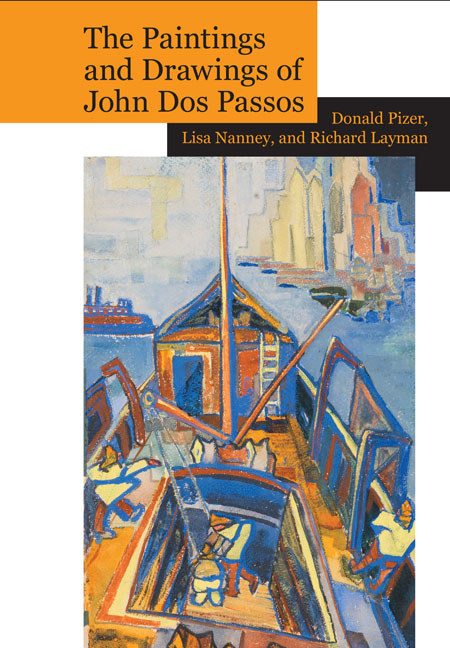Book contents
- Frontmatter
- Contents
- Preface
- Acknowledgments
- The Paintings and Drawings of John Dos Passos: A Collection and Study
- Introduction
- Paintings and Drawings Included in this Volume: A Descriptive List
- Preface to Section 1: Early Work 1918–20
- Preface to Section 2: The Middle East and Morocco 1921–22, 1926
- Preface to Section 3: Paris 1921–25
- Preface to Section 4: New York 1920–24
- Preface to Section 5: New York: Nudes 1920–23
- Preface to Section 6: Theater Designs 1925–28
- Preface to Section 7: Mexico 1926–32
- Preface to Section 8: Later Work 1930–70
- Preface to Section 9: Portraits
- Preface to Section 10: Sea Fronts and Harbors
- Preface to Section 11: Still Lifes
- Preface to Section 12: Studies in Motion
- Preface to Section 13: Abstractions and Other Experimental Modes
- Words and Images: The Visual Art of John Dos Passos
- The Artwork of John Dos Passos
- Notes
- Works Cited
- Index
- Plate section
Preface to Section 2: The Middle East and Morocco 1921–22, 1926
from The Paintings and Drawings of John Dos Passos: A Collection and Study
- Frontmatter
- Contents
- Preface
- Acknowledgments
- The Paintings and Drawings of John Dos Passos: A Collection and Study
- Introduction
- Paintings and Drawings Included in this Volume: A Descriptive List
- Preface to Section 1: Early Work 1918–20
- Preface to Section 2: The Middle East and Morocco 1921–22, 1926
- Preface to Section 3: Paris 1921–25
- Preface to Section 4: New York 1920–24
- Preface to Section 5: New York: Nudes 1920–23
- Preface to Section 6: Theater Designs 1925–28
- Preface to Section 7: Mexico 1926–32
- Preface to Section 8: Later Work 1930–70
- Preface to Section 9: Portraits
- Preface to Section 10: Sea Fronts and Harbors
- Preface to Section 11: Still Lifes
- Preface to Section 12: Studies in Motion
- Preface to Section 13: Abstractions and Other Experimental Modes
- Words and Images: The Visual Art of John Dos Passos
- The Artwork of John Dos Passos
- Notes
- Works Cited
- Index
- Plate section
Summary
(Figures 8–13)
Dos Passos's visit to the Middle East between July 1921 and February 1922 occurred at the tail end of almost a full year abroad that had begun in March 1921 when he and E. E. Cummings spent several months traveling in Spain and France. It had its starting point at Constantinople and included travel by boat, train, automobile, horse-drawn carriage, and camel through the Caucasus region and then to Teheran, Baghdad, and Damascus before concluding in Beirut. The initial portion of the journey was through a war-ravaged area and Dos Passos suffered an attack of malaria in Baghdad, but he nevertheless enjoyed himself immensely. As he noted in The Best Times, his motive for making the trip was that “It was the only region still highly colored enough to suit my craving for new sights” (90). He wrote his friend Robert Hillyer in October 1921 from Teheran, one of several lengthy breaks in the journey, “As for the gorgeous East—People dye their beards henna and wear domed and enormous hats of felt, and robes of cinnamon color and parrot-green silk … and the roads are full of striding camels.”
Dos Passos exhibited twelve Middle East paintings in his 1923 Whitney show, several of which are also among the eight paintings included in his later account of his journey, Orient Express (1927). (The book's title alludes to the famous train from Vienna to Constantinople and perhaps also, ironically, to the slow pace of Dos Passos's travels through the region.) Several of his Middle East paintings reveal his fascination with the Arab bazaar as a reflection of Middle Eastern life. Figure 8, Baghdad Bazaar, for example, stresses the over-whelming impact of the sun upon a milling marketplace crowd. “Chleuh” (fig. 9), which served as the frontispiece of Orient Express, offers a problem in dating and nomenclature; though its title refers to the Berber area of southern Morocco, the text of Orient Express is devoted entirely to Dos Passos's 1921–22 Middle Eastern trip. But since Dos Passos returned from Morocco in February 1926 and Orient Express was published in March 1927, he might have indeed painted it in response to that journey despite its anomalous presence in Orient Express.
- Type
- Chapter
- Information
- Publisher: Liverpool University PressPrint publication year: 2016



